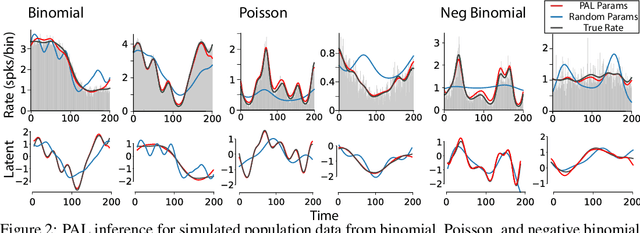Jacob L. Yates
A prescriptive theory for brain-like inference
Oct 25, 2024



Abstract:The Evidence Lower Bound (ELBO) is a widely used objective for training deep generative models, such as Variational Autoencoders (VAEs). In the neuroscience literature, an identical objective is known as the variational free energy, hinting at a potential unified framework for brain function and machine learning. Despite its utility in interpreting generative models, including diffusion models, ELBO maximization is often seen as too broad to offer prescriptive guidance for specific architectures in neuroscience or machine learning. In this work, we show that maximizing ELBO under Poisson assumptions for general sequence data leads to a spiking neural network that performs Bayesian posterior inference through its membrane potential dynamics. The resulting model, the iterative Poisson VAE (iP-VAE), has a closer connection to biological neurons than previous brain-inspired predictive coding models based on Gaussian assumptions. Compared to amortized and iterative VAEs, iP-VAElearns sparser representations and exhibits superior generalization to out-of-distribution samples. These findings suggest that optimizing ELBO, combined with Poisson assumptions, provides a solid foundation for developing prescriptive theories in NeuroAI.
Poisson Variational Autoencoder
May 23, 2024



Abstract:Variational autoencoders (VAE) employ Bayesian inference to interpret sensory inputs, mirroring processes that occur in primate vision across both ventral (Higgins et al., 2021) and dorsal (Vafaii et al., 2023) pathways. Despite their success, traditional VAEs rely on continuous latent variables, which deviates sharply from the discrete nature of biological neurons. Here, we developed the Poisson VAE (P-VAE), a novel architecture that combines principles of predictive coding with a VAE that encodes inputs into discrete spike counts. Combining Poisson-distributed latent variables with predictive coding introduces a metabolic cost term in the model loss function, suggesting a relationship with sparse coding which we verify empirically. Additionally, we analyze the geometry of learned representations, contrasting the P-VAE to alternative VAE models. We find that the P-VAEencodes its inputs in relatively higher dimensions, facilitating linear separability of categories in a downstream classification task with a much better (5x) sample efficiency. Our work provides an interpretable computational framework to study brain-like sensory processing and paves the way for a deeper understanding of perception as an inferential process.
Efficient non-conjugate Gaussian process factor models for spike count data using polynomial approximations
Jun 07, 2019



Abstract:Gaussian Process Factor Analysis (GPFA) has been broadly applied to the problem of identifying smooth, low-dimensional temporal structure underlying large-scale neural recordings. However, spike trains are non-Gaussian, which motivates combining GPFA with discrete observation models for binned spike count data. The drawback to this approach is that GPFA priors are not conjugate to count model likelihoods, which makes inference challenging. Here we address this obstacle by introducing a fast, approximate inference method for non-conjugate GPFA models. Our approach uses orthogonal second-order polynomials to approximate the nonlinear terms in the non-conjugate log-likelihood, resulting in a method we refer to as polynomial approximate log-likelihood (PAL) estimators. This approximation allows for accurate closed-form evaluation of marginal likelihood and fast numerical optimization for parameters and hyperparameters. We derive PAL estimators for GPFA models with binomial, Poisson, and negative binomial observations, and additionally show that the parameters obtained can be used to initialize black-box variational inference, which significantly speeds up and stabilizes the inference procedure for these factor analytic models. We apply these methods to data from mouse visual cortex and monkey higher-order visual and parietal cortices, and compare GPFA under three different spike count observation models to traditional GPFA. We demonstrate that PAL estimators achieve fast and accurate extraction of latent structure from multi-neuron spike train data.
 Add to Chrome
Add to Chrome Add to Firefox
Add to Firefox Add to Edge
Add to Edge